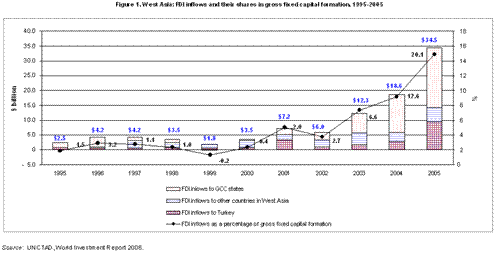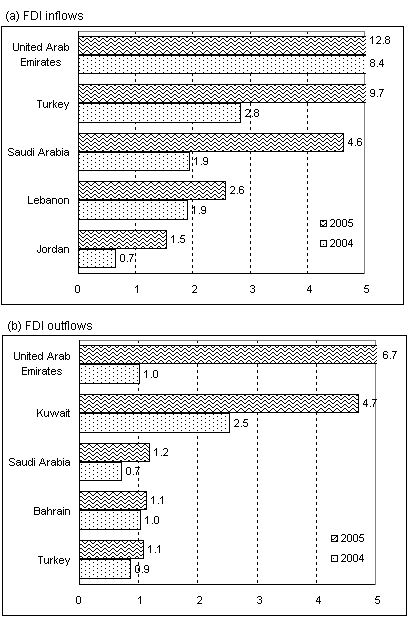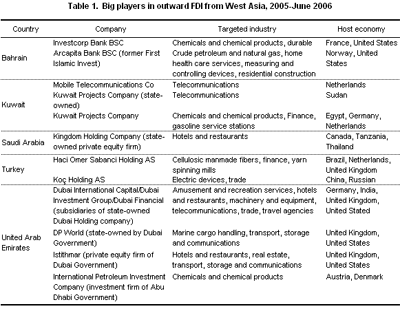| EMBARGO The contents of this press release and the related Report must not be quoted or summarized in the print, broadcast or electronic media before 16 October 2006, 17:00 GMT (1 PM New York, 19:00 Geneva, 22:30 Delhi, 02:00 - 17 October Tokyo) |
Foreign direct investment (FDI) flows in West Asia achieved record highs in both inward (US$34 billion) and outward (US$16 billion) directions in 2005 (figure 1), says UNCTAD´s World Investment Report 2006, FDI from Developing and Transition Economies: Implications for Development (1).
Strong economic growth, global oil demand and an improved investment environment played crucial roles in the historic surge of FDI inflows.
Oil-rich countries contributed to the growth in FDI outflows from the region and at the intra-regional level.
In 2005, FDI inflows to West Asia rose by 85% -- the highest growth rate in the developing world. They increased in 12 countries out of 14 in the region. The United Arab Emirates attracted the largest amount (US$12 billion), followed by Turkey (US$9.7 billion) and Saudi Arabia (US$4.6 billion). Those three economies accounted for over three quarters of the region´s inflows (figure 2). FDI is taking place increasingly at the intra-regional level, particularly in the services sector (for example, in telecommunications and finance), reaching US$14 billion in 2005 in cross-border mergers and acquisitions (M&As) alone, as compared to US$0.6 billion in 2004. The upward shift is partly the result of privatizations promoted in countries such as Bahrain, Jordan, Oman, Turkey and the United Arab Emirates. "Greenfield" Investments are mainly being undertaken in energy-related manufacturing industries.
In 2005, FDI outflows from West Asia more than doubled. Oil-rich Gulf countries are traditionally active in portfolio investments abroad. However, they are now allocating more petrodollars to FDI, and are investing widely not only at the intra-regional level but in developing Asia and Africa and in the developed world. Significant recipient industries include energy, tourism, and telecommunications. State-owned companies are active investors (table 1).
These trends partly reflect a progressively relaxed regulatory framework for FDI.. Most countries in the region have liberalized regulations, in particular for non-energy industries such as finance, real estate and telecommunications. These industries consequently attracted much of the region´s FDI in 2005. If there are continued efforts towards economic reform and further improvements to the business climate, supported by promising economic growth and high oil prices, further increases in FDI flows - both inward and outward - are likely. However, given continuing geopolitical uncertainty, these flows may be unevenly spread in the region.
| The World Investment Report and its database are available online at http://www.unctad.org/wir and http://www.unctad.org/fdistatistics |
ANNEX
Tables and figures
Figure 1. West Asia: FDI inflows and their share in gross fixed capital formation, 1995-2005
Source: UNCTAD, World Investment Report 2006
Figure 2. West Asia: FDI flows, top five economies,a 2004, 2005 (Billions of dollars)
Source: UNCTAD, World Investment Report 2006
Note: a Ranked on the basis of the magnitude of 2005 FDI flows.
Table 1. West Asia: Big players in outward FDI from West Asia, 2005-June 2006
Source: UNCTAD, World Investment Report 2006


